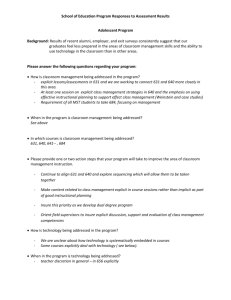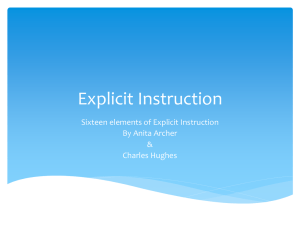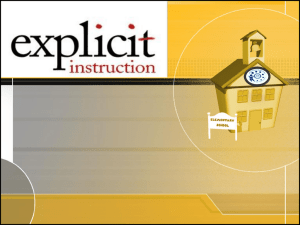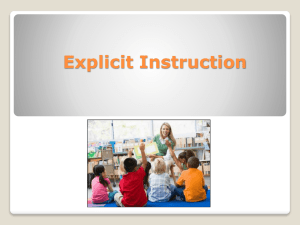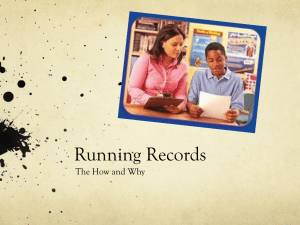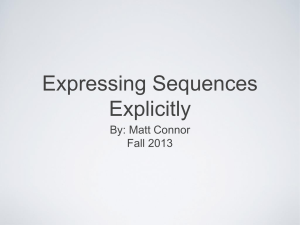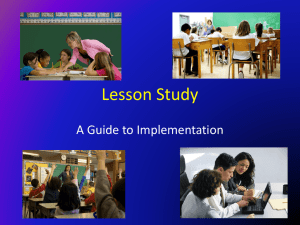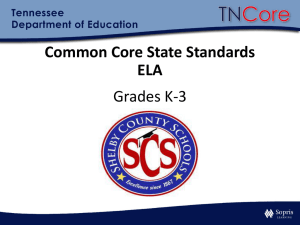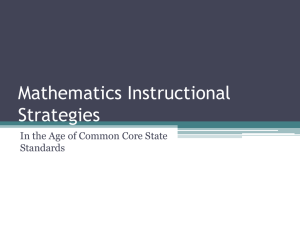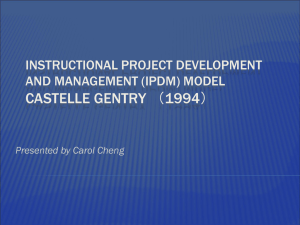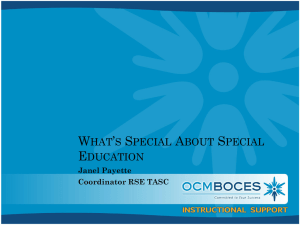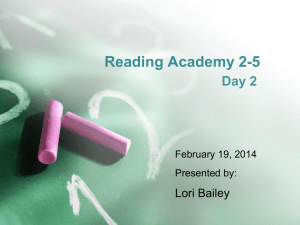Explicit Instruction - When, where, and how (new window)
advertisement
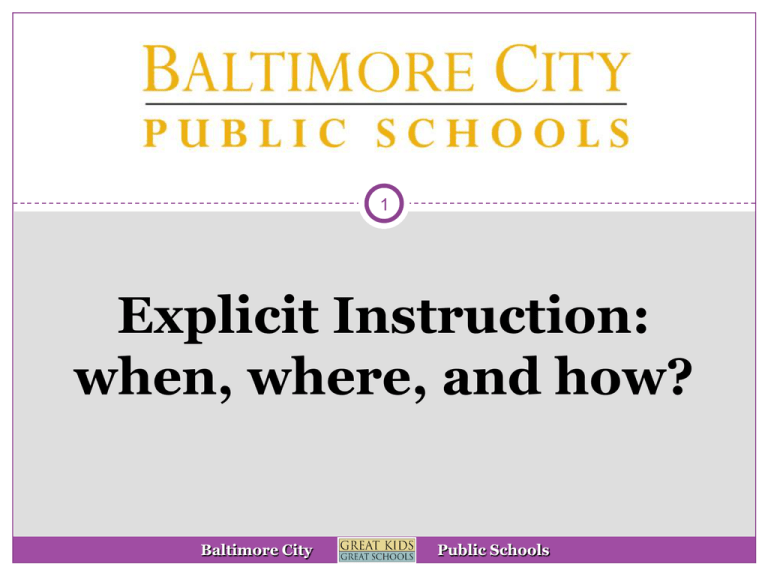
1 1 Explicit Instruction: when, where, and how? Baltimore City Public Schools Professional Norms 2 Engage in the activities Limit “techno-stractions” Maintain a solution oriented posture Honor time limits * Parking lot for questions & feedback Session Goals 3 Participants will… Articulate the district’s definition of Explicit Instruction Identify where Explicit Instruction can be utilized within the district’s Instructional Model for Literacy Identify teaching elements used within a Focus Lesson that are examples of Explicit Instruction Make connections between Explicit Instruction and district wide initiatives Stop and Jot 4 On the index card provided respond to the questions below: What do you know about Explicit Instruction? What do you think should be happening? (3 minutes) Share your response with a partner (2 minutes) Explicit Instruction… 5 is a structured, systematic and effective methodology for teaching academic skills. It is called explicit because it is an unambiguous and direct approach to teaching that includes both instructional design and delivery procedures. Explicit instruction is characterized by a series of supports or scaffolds, whereby students are guided through the learning process with clear statements about the purpose and rationale for learning the new skill, clear explanations and demonstrations of the instructional target, and supported practice with feedback until independent mastery has been achieved (Archer & Hughes, 2011). Explicit Instruction… 6 is a structured, systematic and effective methodology for teaching academic skills. It is called explicit because it is an unambiguous and direct approach to teaching that includes both instructional design and delivery procedures. Explicit instruction is characterized by a series of supports or scaffolds, whereby students are guided through the learning process with clear statements about the purpose and rationale for learning the new skill, clear explanations and demonstrations of the instructional target, and supported practice with feedback until independent mastery has been achieved (Archer & Hughes, 2011). Model of Explicit Instruction: Gradual Release of Responsibility 7 TEACHER RESPONSIBILITY Focus Lesson Model “I do it” “We do it” Guided Instruction Collaborative “You do it together” Independent Share “You do it alone” STUDENT RESPONSIBILITY Fisher, D., & Frey, N. (2008). Better learning through structured teaching: A framework for the gradual release of responsibility. Alexandria, VA: Association for Supervision and Curriculum Development. What it’s not: The Sudden Release of Responsibility 8 TEACHER RESPONSIBILITY Model/ Focus Lesson “I do it” Model “You do it alone” Independent STUDENT RESPONSIBILITY Fisher, D., & Frey, N. (2008). Better learning through structured teaching: A framework for the gradual release of responsibility. Alexandria, VA: Association for Supervision and Curriculum Development. Gradual Release of Responsibility 9 The gradual release model of instruction suggests that the cognitive load should shift slowly and purposefully from teacher as model to joint responsibility to independent practice and application by the learner (Pearson and Gallagher 1983) “ effective instruction often follows a progression in which the teachers gradually do less of the work and students gradually assume increased responsibility for their learning. It is through this process of gradually assuming more and more responsibility for their learning that students become competent, independent learners”. (Graves and Fitzgerald 2003) 10 10 Model / Focus Lessons Explicit Instruction and the Gradual Release of Responsibility Guided Independent Shared/ Collaborative 11 Professional Reading 12 12 Directions: Read pages 4 – 10 (top of page) and code the text using the punctuations below. Summarize and share ideas with a partner. (20 minutes) != Important * =Interesting ?= Questions Our Mission… 13 Baltimore City Schools will prepare critical and analytical thinkers for the 21st century who read with comprehension and enthusiasm; listen with understanding and empathy; speak with conviction and authority; and write with clarity and purpose. We will achieve this mission by providing and supporting a comprehensive literacy instructional model for teachers, school leaders, and communities. 14 Inside the Instructional Model: Whole Group Reading Instruction 15 Whole Group Reading Instruction (daily) 10-20 minutes - Focus Lessons (explicit teaching of a reading strategy, skill, or concept) - Interactive Read-alouds - Think-alouds - Shared Reading - Close Reading 15 VideoLook Look For’s Video For’s 16 16 As you watch the video use the look for sheet to capture any evidence of the gradual release of responsibility. Video 17 Model/ Focus Lesson What is the teacher doing? 18 18 What are the students doing? Focusing on a single teaching point Watching what the teacher is doing Explicitly showing the students a Preparing to participate learning behavior through modeling Using only 10‐15 minutes of instructional time Guided What is the teacher doing? Providing opportunities for students to verbalize thoughts Listening in to conversations to assess understanding Inviting students to “give it a try” scaffolding release of some responsibility for learning to students Differentiating through adapting content, process, or product Making thinking visible with some form of writing 19 19 What are the students doing? Practicing modeled skill or behavior Turning & Talking Making thinking visible with some form of writing Shared/Collaborative What is the teacher doing? Creating opportunities for student collaboration 20 20 What are the students doing? Discussing ideas and concepts Practicing a previous teaching point Taking anecdotal notes Making connections between Facilitating or scaffolding small group work Listening to students content and their own lives Explaining processes Checking each other’s understanding Making a contribution to the joint effort or project Reflecting upon & assessing group and personal learning Independent What is the teacher doing? Conferring with students Observing and taking anecdotal notes Assessing individual student responses 21 21 What are the students doing? Strategically and independently applying strategies & skills in authentic situations Taking responsibility for learning Keeping records of learning Reflecting upon personal growth Assessing personal progress Gradual Release of Responsibility Model 22 TEACHER RESPONSIBILITY Model “I do it” Focus Lesson “We do it” Guided Instruction Collaborative “You do it together” Independent Share “You do it alone” STUDENT RESPONSIBILITY Fisher, D., & Frey, N. (2008). Better learning through structured teaching: A framework for the gradual release of responsibility. Alexandria, VA: Association for Supervision and Curriculum Development. Inside the A Closer Look Instructional Teach Plan P1 Know your students P2 Set and track goals based on student performance levels P3 T1 Communicate standards-based lesson objectives T2 Present content clearly T3 Use strategies and tasks to engage all students in rigorous work Use evidence dependent questioning Develop standards-based units and long-term plans T4 Design lessons to meet learners’ unique needs T5 P5 Use and align resources strategically T6 P6 Mobilize families and stakeholders in support of student success T7 Organize classroom space and materials T9 P4 P7 23 Framework T8 Check for understanding and Provide specific, academic feedback Facilitate student-to-student interaction and academic talk Implement routines to maximize instructional time Build a positive, learning focused classroom culture Reinforce positive behavior, redirect off-task behavior, and deescalate challenging behavior Reflect & Adjust RA 1 Analyze student progress toward goals RA 2 Modify instruction in response to data RA 3 Assess and refine classroom space and culture RA4 Partner with students and families to reflect on student’s progress Explicit Instruction: A Daily Practice 24 24 Take-Away’s What resonated with you? How has your thinking changed or been challenged? Implications for my work How can I use my current resources? What can I try immediately? Thoughts to ponder… 25 “Explicit teaching is not just merely giving students clear directions or even stating the learning goals at the beginning of a lesson – it is a way of thinking about and acting out teaching and learning in a principled way throughout the lesson (from assessment through to planning implementation and review).” (Christine Edwards‐Groves 2002) Closing 26 Please fill out the evaluation!
